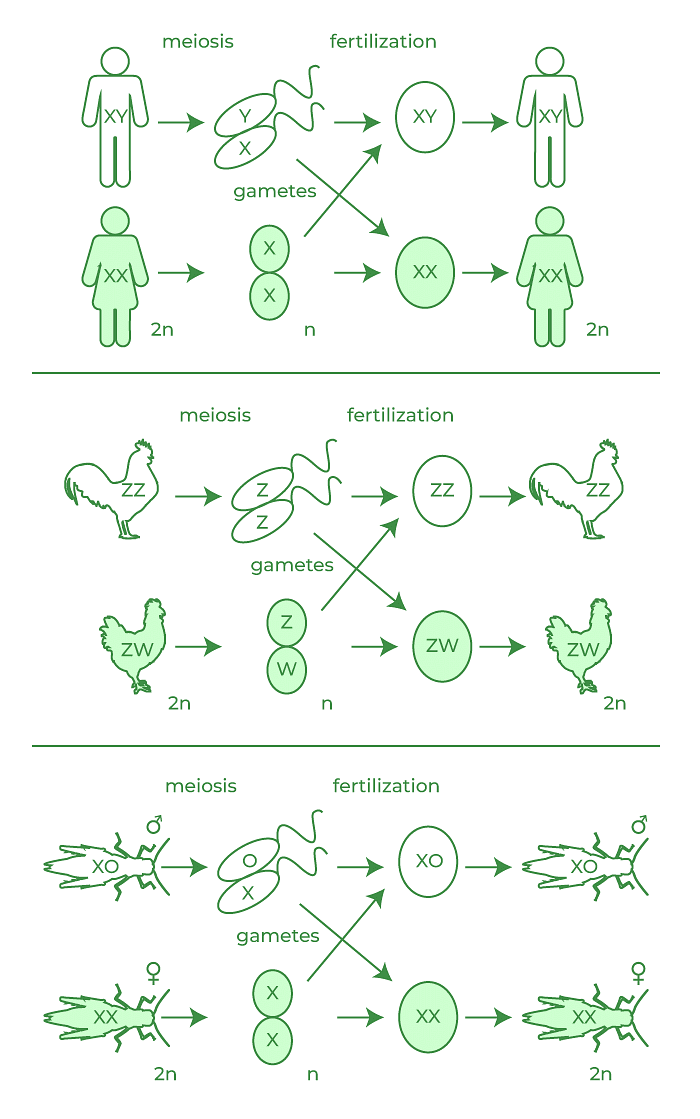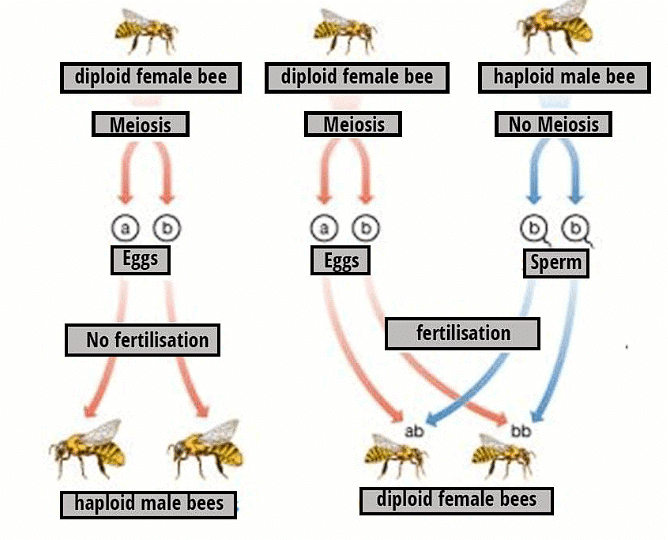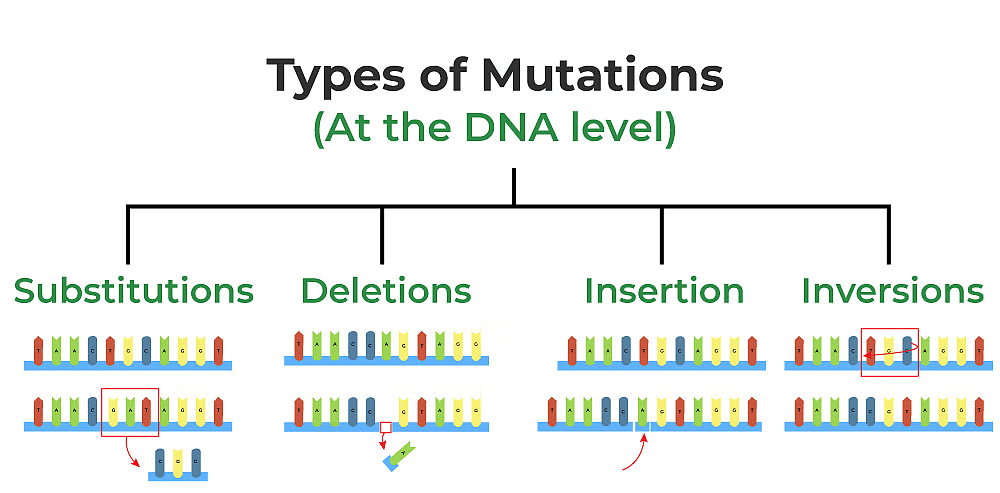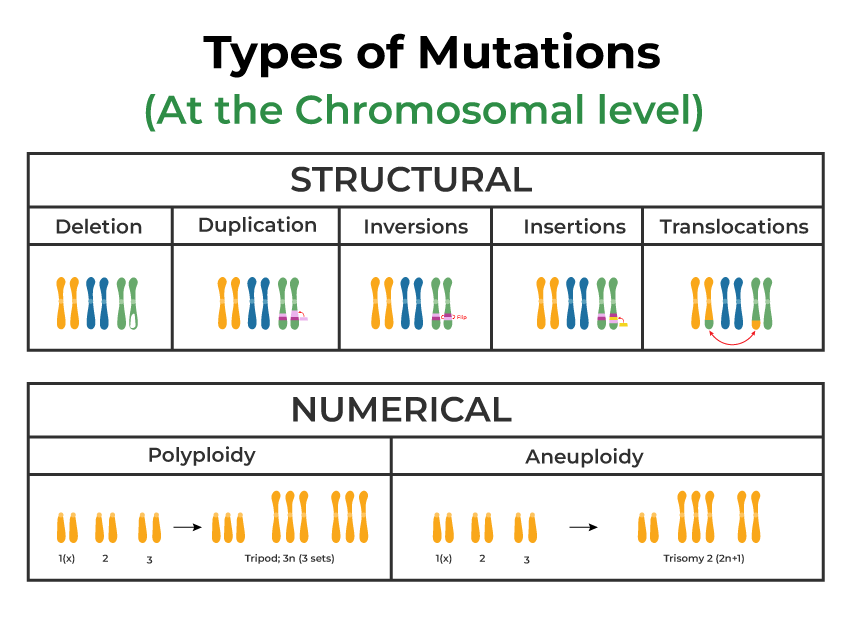Sex Determination and Mutation | Biology Class 12 - NEET PDF Download
Genetic information is passed from parents to offspring through asexual or sexual reproduction. Heredity, also known as biological inheritance, involves transferring traits from parents to their offspring. Genetics, the study of heredity in biology, focuses on the genotype, which represents the complete set of genes in an individual. Genes control all inherited traits in an organism.
- Evolution:
Evolution is the change in heritable characters in a population over successive generations. Genes are passed from parents to offspring, leading to the expression of various characteristics. Factors like natural selection and genetic drift drive evolution, causing variations at different levels of biological organization. Evolution is essential for the survival and adaptation of species.
- Natural Selection:
Natural selection determines an organism's fitness for survival through various means. Behavioral and structural traits vary among populations, affecting the rate of reproduction and survival. Fit traits are passed on to future generations, contributing to the evolutionary process. The biodiversity we observe today is a result of the continual evolution of species.

Sex Determination
The process of identifying the sexual characteristics of an individual is referred to as sex determination. Typically, in sexual reproduction, offspring are born as one of two sexes. Some species exhibit hermaphroditic traits, featuring both male and female reproductive organs in a single individual. Parthenogenesis, a method where a female reproduces without fertilization, leads to the birth of offspring of a single sex.
Genetic Basis
Sexual characteristics or morphology are determined by various genes or alleles. Sex determination is primarily a genetic process, influenced by different combinations of chromosomes such as XY, ZW, XO, among others. A key gene known as the sex locus plays a pivotal role in differentiating an organism's sex, with other genes following suit.
1. Environmental Influence
Environmental factors can also impact the sex of a fetus. While current systems may not guarantee accurate sex determination of a fetus, ongoing research aims to develop technologies that can analyze reproductive signals to predict offspring sex in a more precise manner.
2. Medical Applications
In the past, sex determination techniques were developed to identify and potentially treat genetic and hormonal diseases in fetuses. By examining cells from the fetus, tests could determine the fetus's sex as well as any accompanying diseases. Unfortunately, misuse of these techniques, such as selective abortion based on sex, led to governmental restrictions on revealing fetal sex during tests.

Sex Determination in Humans
(a) XY/XX Sex Chromosomes
XY/XX sex chromosomes are commonly found in humans, mammals, and some insects. In this system, males have XY chromosomes, while females have XX chromosomes. These chromosomes differ in size and shape. In fruit flies, sex is determined upon fertilization of the egg, whereas in humans, sex is determined later.
Sex Determination of Honeybees
Honeybees use a haplodiploid sex determination mechanism. Males develop from unfertilised eggs as haploids, whereas females develop from fertilised eggs as diploids. Sterile diploid female bee and fertile diploid female bee, in which former one will act as a worker and latter one as a queen.

- The fertilisation or non-fertilisation of the eggs, rather than the presence or lack of sex chromosomes, determines sex in honeybees.
- The male progeny of honeybees develops naturally from unfertilised eggs, which are haploid and have only one set of chromosomes.
- Queens and worker bees are male or female and are produced from fertilised honey bee eggs, which are diploid and have two sets of chromosomes.
- Number of chromosomes in honey bees: Diploid females have 16 pairs of chromosomes, or 32, whereas haploid males only have 16 single chromosomes.
Mutation
The human body, though appearing simple from the outside, is a complex entity comprising various intricate processes. Genes or DNA serve as the micro-controlling regions within the human body, surpassing the brain in significance. The brain's operations are reliant on DNA and its sequences. Any alterations in this structure can prove to be detrimental to the body.
Mutation signifies a type of alteration within the DNA structure, carrying potential consequences for the individual's physiological functions.
DNA or genes are composed of specific amino acid sequences that play a crucial role in the structure and function of the human body. If changes occur due to external factors, the sequence of amino acids may alter, leading to DNA or gene malfunction, causing a significant impact on the body. This phenomenon is known as Mutation.
- Mutations can be detrimental as they disrupt the process of protein generation by DNA. For instance, a mutation in DNA can result in the production of numerous defective mRNA molecules, which in turn can lead to the synthesis of a large number of improper proteins, affecting various bodily functions.
- Mutations at the DNA level are particularly dangerous, as they are challenging to rectify. Cells possess mechanisms to detect and repair mutations in DNA promptly to prevent adverse consequences and ensure the production of functional proteins.
Causes of Mutation
The process of mutation is influenced by various factors, leading to alterations in the body's DNA. These factors can be categorized into two main types.
- Internal Mutation: This type of mutation is frequently observed and plays a crucial role in the evolution process. DNAs undergo splitting during cell division, resulting in changes to the genomic sequences and consequently, mutations in the DNA.
- External Mutation: This form of mutation is rare and involves external factors such as chemicals or agents interacting with the DNA. For instance, UV rays can cause mutations by affecting specific DNA bases like Thymine, leading to alterations in the DNA sequences.
Understanding these causes of mutation is essential in comprehending the mechanisms behind genetic variability and evolution.
General Characteristics of Mutation
- There are specific characteristics defining mutation, delineating the general properties of this ongoing process, which unfolds gradually in incremental steps.
- In general, mutations affecting the body tend to exhibit recessive traits primarily, although instances of dominant mutations are feasible but rare. As such, the mutation process often manifests recessive characteristics in nature.
- Mutations typically result in deleterious traits for an organism, implying that the mutation process frequently engenders harmful alterations. Nonetheless, occasionally, a mutation might confer advantages to the organism.
- Mutation events usually transpire randomly, indicating that mutations can emerge at any gene locus, dictated by chance.
- Mutations tend to recur in a patterned manner; thus, if a gene undergoes mutation once, there exists a possibility of subsequent mutations. Consequently, the mutation process demonstrates a recurrent nature.
- Mutations often lead to the generation of new genes from mutated ones. This phenomenon illustrates the pleiotropy effect within genes due to the mutation process.
Role of Mutation
Scientists commonly associate mutations with the occurrence of harmful processes in the body, potentially leading to an individual's demise. Mutations are often linked to the development of specific diseases, although not all mutations result in fatality. Interestingly, mutations can sometimes have beneficial effects, aiding in an individual's survival in nature.- Mutation is a fundamental process in the evolution of species, shaping the diversity of life forms present today.
- The current biodiversity is a direct result of the cumulative effects of mutations over time.
- Organisms have utilized mutations for their advantage, contributing to their survival and adaptation to changing environments.
Example: Sickle Cell Anemia
- Sickle Cell Anemia, caused by a mutation in red blood cells, is a well-known disease.
- While this condition leads to health challenges, it has served as a protective mechanism against severe Malaria in certain populations, particularly in Africa.
- This example demonstrates how mutations can have both negative and positive impacts on individuals, influencing their survival in nature.
Classification and Types of Mutation
- Spontaneous Mutation: Spontaneous Mutation is a unique form of mutation that occurs within an organism without any external influence. This type of mutation initiates internally, often associated with factors within the organism itself. For instance, processes like DNA replication can lead to Spontaneous Mutation. The term "spontaneous" implies occurrences without external agents, making it aptly named for this mutation process.
- Induced Mutation: Induced Mutation stands in contrast to Spontaneous Mutation. It requires the introduction of external agents into the organism to trigger the mutation process. These agents, known as Mutagens, are responsible for inducing mutations. External factors like UV rays can act as mutagens, causing alterations or breaks in the DNA when they interact with it. The term "induced" reflects the necessity of external agents for this mutation process.
Types of Mutation Based on Location
When focusing on mutations based on their location, they can be classified into two main categories: Point Mutation and Chromosomal Mutation
1. Point Mutation

- Substitution Process: Mutation occurs in the DNA sequence where a base is substituted by another. This changes the DNA sequence, affecting protein synthesis.
- Insertion Process: Amino acids are inserted randomly into the DNA sequence, altering its structure and disrupting protein synthesis.
- Deletion Process: An amino acid in the DNA sequence is deleted, leading to changes in the DNA sequence, protein synthesis, and overall DNA processes.
2. Chromosomal Mutation
The chromosomal mutation process involves mutations at the chromosome base or changes in the number of chromosomes, which can have various sub-types.

Numerical Mutations in Chromosomal Mutation
When considering chromosomal mutations, it's essential to note that alongside structural mutations, there exists another category known as numerical mutations. Unlike structural mutations that alter the chromosome's structure, numerical mutations affect the number of chromosomes present. There are two main types of numerical mutations:
- Polyploidy: Polyploidy is a numerical mutation where a cell contains more than the usual diploid number of chromosomes. Typically, a human cell has 23 pairs of chromosomes. However, in cases of polyploidy, additional chromosomes are present, leading to a total exceeding 46. This condition is termed Polyploidy.
- Aneuploidy: Aneuploidy, on the other hand, involves a decrease in the number of chromosomes within a cell, differing from the concept of Polyploidy. This mutation results in a chromosome count lower than the standard 46 pairs. Aneuploidy can occur due to mutations in cells, leading to changes in the chromosome count.
Additionally, there is another type of mutation known as Copy Number Variation Mutation
Other Types of Mutation
Mutation at the Protein Level

After chromosomal level mutations, mutations at the protein level can impact protein synthesis directly, known as Protein Level Mutation.
- Silent Mutation: A type of mutation occurring in the gene's protein-coding region, where no amino acid sequence change affects protein synthesis.
- Missense Mutation: Involves a base substitution at the gene protein level, leading to the synthesis of a different protein from the original, impacting functionality.
- Nonsense Mutation: Results in a nonfunctional protein due to changes in the gene's protein region, contrasting with missense mutations where the protein retains functionality.
- Frameshift Deletion Mutation: Causes the deletion of continuous gene bases, resulting in a shorter gene length and shifting the protein frame, affecting protein development.
- Frameshift Insertion Mutation: Involves the addition of bases to the gene, increasing gene length and shifting the protein area, leading to errors in protein production.
Importance of Mutation
- Mutation plays a crucial role in the human body, often viewed as a potentially harmful change.
- Despite its risks, mutations are essential for the process of evolution.
- Spontaneous mutations introduce new traits that can be advantageous for survival in nature.
- These beneficial mutations are passed on to future generations, shaping genetic characteristics.
FAQs on Mutation
Question 1: What is mutation?
Mutation is a process that involves changes in DNA genetic sequences, leading to the presence of malfunctioning DNA in the body. This can disrupt essential processes and result in various changes in the body.
Question 2: What are mutagens?
Mutagens are agents or elements that play a role in the mutation process. These external factors impact the mutation process and are known as mutagens. For instance, UV rays are considered mutagens.
Question 3: Are all mutations inheritable?
Not all mutations are inheritable. Some mutations occur in body or somatic cells and are not passed on to the next generation. These are called somatic mutations.
Question 4: What is the beneficial effect of the mutation process?
The beneficial effect of the mutation process is the evolutionary process. Mutations help in developing traits that aid in survival and can lead to the creation of new species.
Question 5: What are Germline Mutations?
Germline mutations occur in reproductive cells like sperm and egg cells. These mutations are heritable and can be passed on to the next generation, potentially causing significant effects if faulty mutations occur.
Please Login to comment...
LoginLike
|
59 videos|290 docs|168 tests
|






















